
Great Lent, or the Great Fast, is the most important fasting season of the church year within many denominations of Eastern Christianity. It is intended to prepare Christians for the greatest feast of the church year, Pascha (Easter).

The liturgical year, also called the church year, Christian year or kalendar, consists of the cycle of liturgical seasons in Christian churches that determines when feast days, including celebrations of saints, are to be observed, and which portions of Scripture are to be read either in an annual cycle or in a cycle of several years.
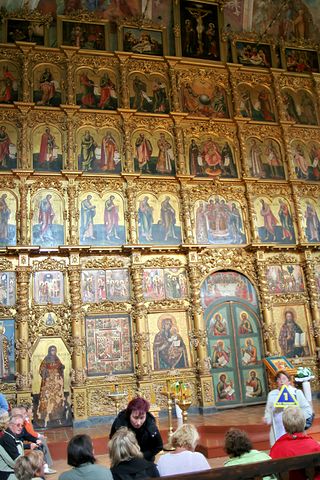
The Byzantine Rite, also known as the Greek Rite or the Rite of Constantinople, is a liturgical rite that is identified with the wide range of cultural, devotional, and canonical practices that developed in the Eastern Christian Church of Constantinople.
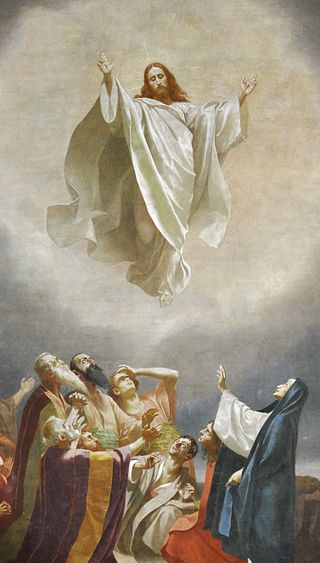
The Feast of the Ascension of Jesus Christ commemorates the Christian belief of the bodily Ascension of Jesus into Heaven. It is one of the ecumenical feasts of Christian churches, ranking with the feasts of the Passion and Pentecost. Following the account of Acts 1:3 that the risen Jesus appeared for 40 days prior to his Ascension, Ascension Day is traditionally celebrated on a Thursday, the fortieth day of Easter, although some Christian denominations have moved the observance to the following Sunday, sometimes called Ascension Sunday. The day of observance varies by ecclesiastical province in many Christian denominations, as with Methodists and Catholics, for example.
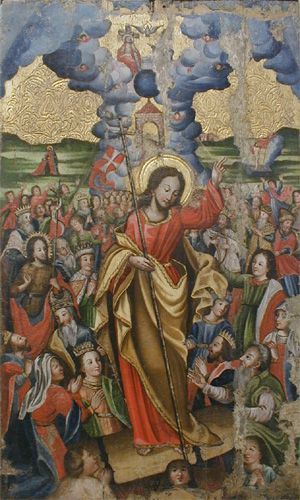
Eastertide or Paschaltide is a festal season in the liturgical year of Christianity that focuses on celebrating the Resurrection of Jesus Christ. It begins on Easter Sunday, which initiates Easter Week in Western Christianity, and Bright Week in Eastern Christianity.
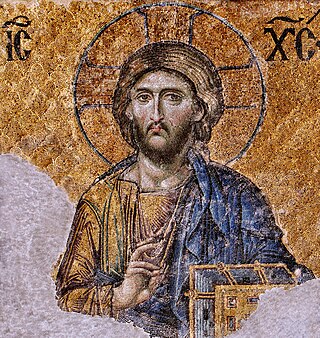
The Eastern Orthodox liturgical calendar describes and dictates the rhythm of the life of the Eastern Orthodox Church. Passages of Holy Scripture, saints and events for commemoration are associated with each date, as are many times special rules for fasting or feasting that correspond to the day of the week or time of year in relationship to the major feast days.

The Paschal cycle, in Eastern Orthodox Christianity, is the cycle of the moveable feasts built around Pascha (Easter). The cycle consists of approximately ten weeks before and seven weeks after Pascha. The ten weeks before Pascha are known as the period of the Triodion, referring to the liturgical book that contains the services for this liturgical season. This period includes the three weeks preceding Great Lent, the "pre-Lenten period", the forty days of Lent, and Holy Week. The 50 days following Pascha are called the Pentecostarion, also named after the liturgical book.

Bright Week, Pascha Week or Renewal Week is the name used by the Eastern Orthodox and Byzantine Rite Catholic Churches for the period of seven days beginning on Easter and continuing up to the following Sunday, which is known as Thomas Sunday.
"Octave" has two senses in Christian liturgical usage. In the first sense, it is the eighth day after a feast, reckoning inclusively, and so always falls on the same day of the week as the feast itself. The word is derived from Latin octava (eighth), with dies (day) understood. In the second sense, the term is applied to the whole period of these eight days, during which certain major feasts came to be observed.

The Gospel in Christian liturgy refers to a reading from the Gospels used during various religious services, including Mass or Divine Liturgy (Eucharist). In many Christian churches, all present stand when a passage from one of the Gospels is read publicly, and sit when a passage from a different part of the Bible is read. The reading of the Gospels, often contained in a liturgical edition containing only the four Gospels, is traditionally done by a minister, priest or deacon, and in many traditions the Gospel Book is brought into the midst of the congregation to be read.

The Paschal trikirion is a liturgical triple-candlestick used at Easter time in the Eastern Orthodox and Byzantine Catholic traditions.
An Afterfeast is a period of celebration attached to one of the Great Feasts celebrated by the Orthodox Christian and Eastern Catholic Churches.

Eastern Orthodox worship in this article is distinguished from Eastern Orthodox prayer in that 'worship' refers to the activity of the Christian Church as a body offering up prayers to God while 'prayer' refers to the individual devotional traditions of the Orthodox.
The Ypakoë is a troparion chanted at Orthros (Matins) and the Midnight Office on Great Feasts and Sundays throughout the liturgical year in the Eastern Orthodox Church. The Ypakoë which is chanted on Sundays is found in the Octoechos and there are eight of them, according to the Tone of the Week. The Ypakoë used at one of the Great Feasts will be written in the tone of the hymnographer's choice.

The Matins Gospel is the solemn chanting of a lection from one of the Four Gospels during Matins in the Orthodox Church and those Eastern Catholic churches which follow the Byzantine Rite.
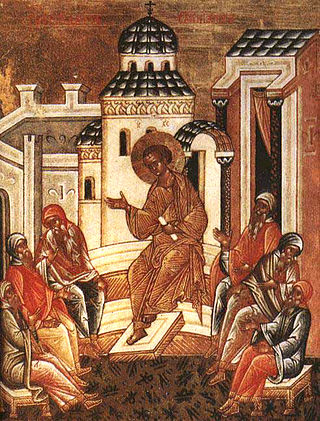
Mid-Pentecost or Midfeast, also Meso-Pentecost is a feast day which occurs during the Paschal season in the Eastern Orthodox Church and those Eastern Catholic Churches and Eastern Lutheran Churches that follow the Byzantine Rite.

A liturgical book, or service book, is a book published by the authority of a church body that contains the text and directions for the liturgy of its official religious services.
The Dismissal is the final blessing said by a Christian priest or minister at the end of a religious service. In liturgical churches the dismissal will often take the form of ritualized words and gestures, such as raising the minister's hands over the congregation, or blessing with the sign of the cross. The use of a final blessing at the end of a liturgical service may be based upon the Priestly Blessing prescribed for the kohanim in the Torah.
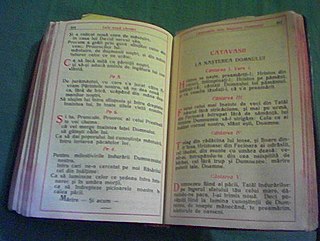
Katabasia or Katavasia is a type of hymn, and the last troparion of an ode of a canon, chanted in the Eastern Orthodox Church and those Eastern Catholic Churches which follow the Byzantine Rite. Its name is derived from the Greek word katabasia for descent, so called because the cantors used to descend from their stalls and unite in the middle of the church to sing them.











